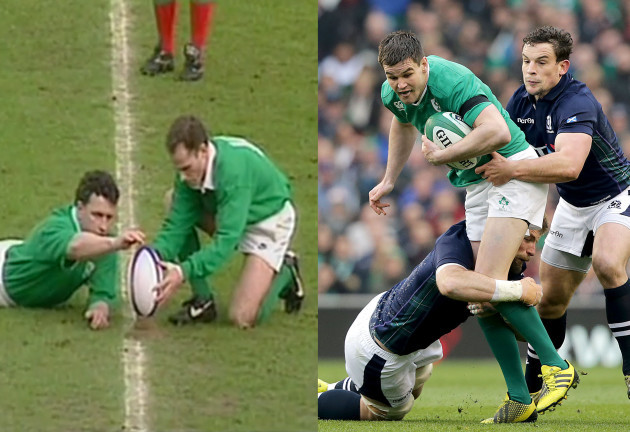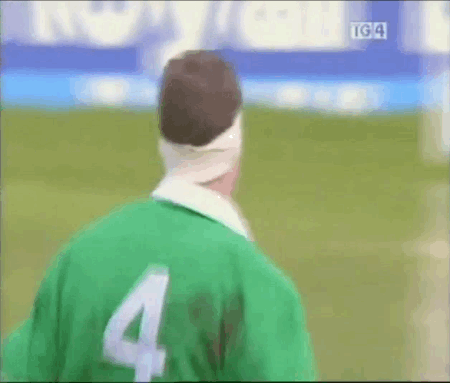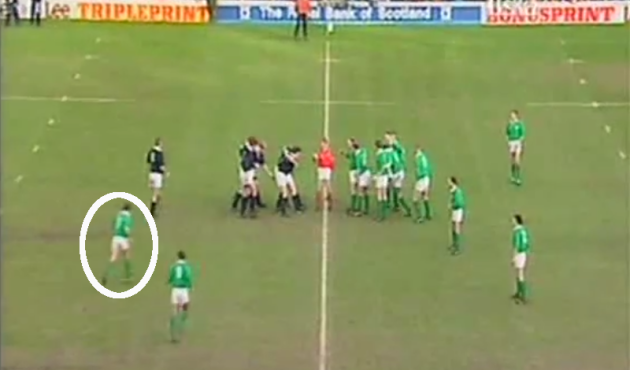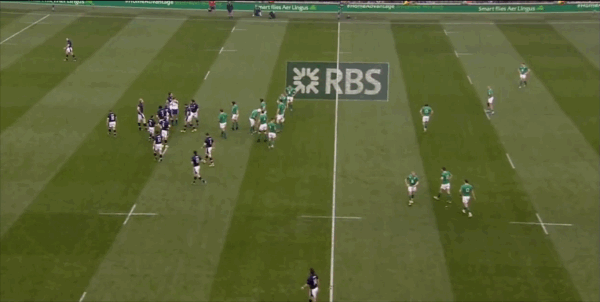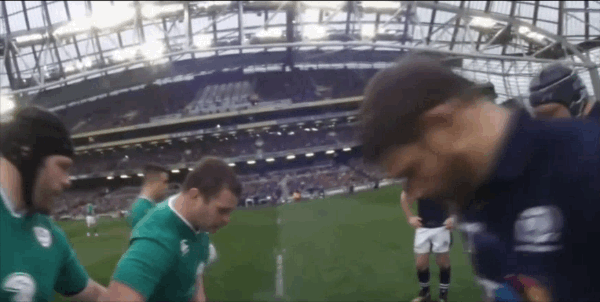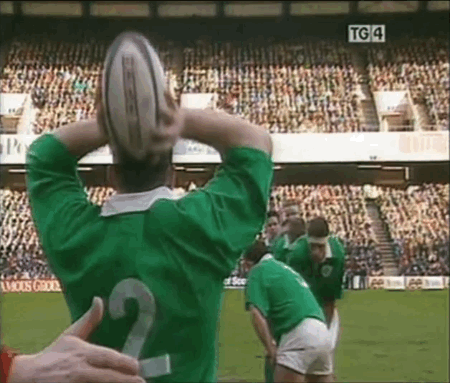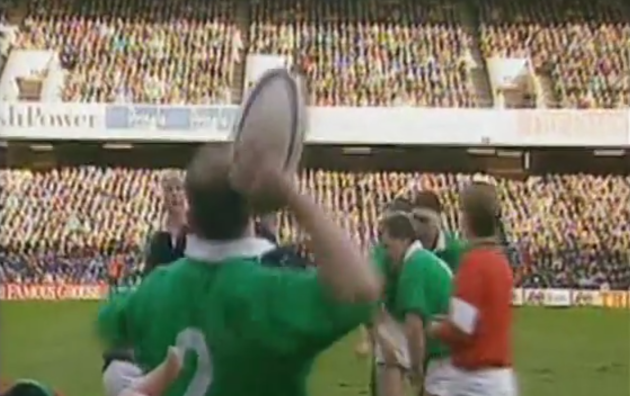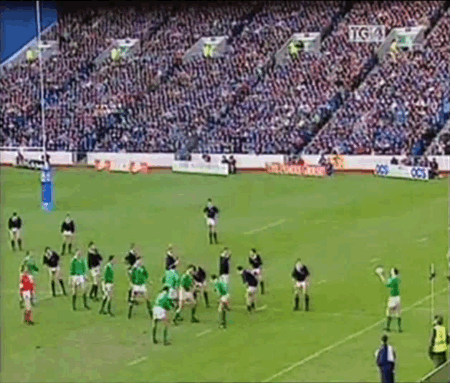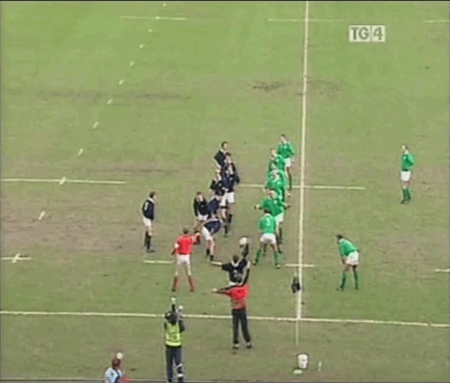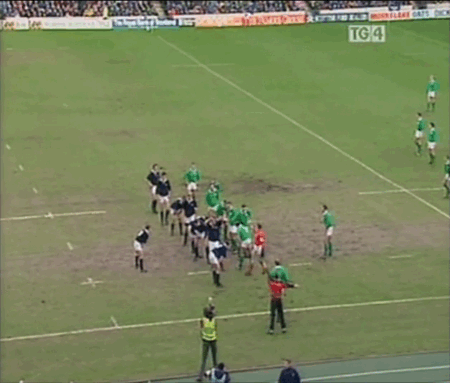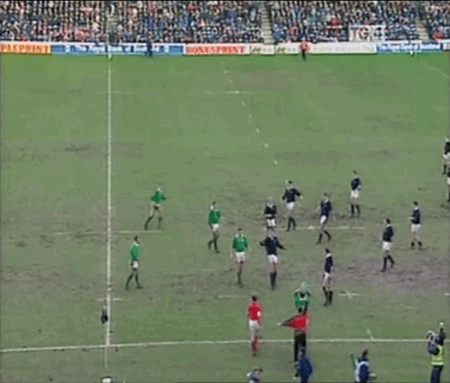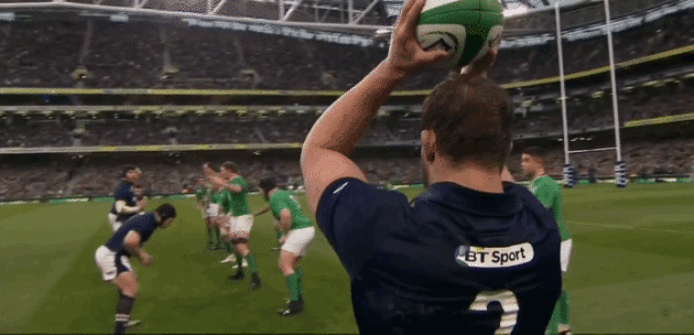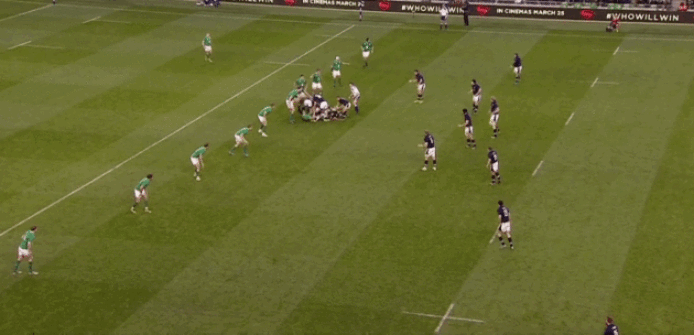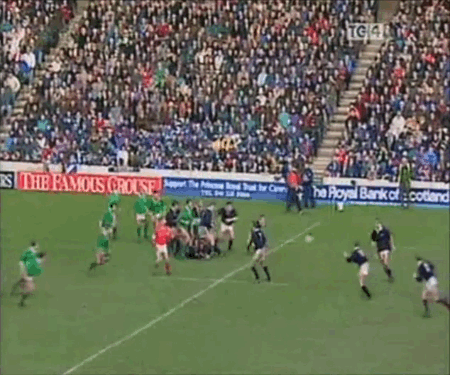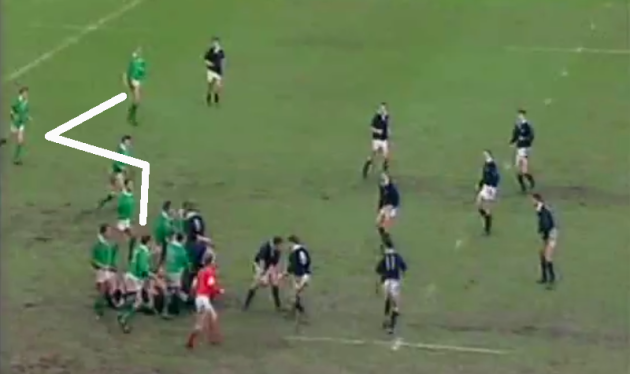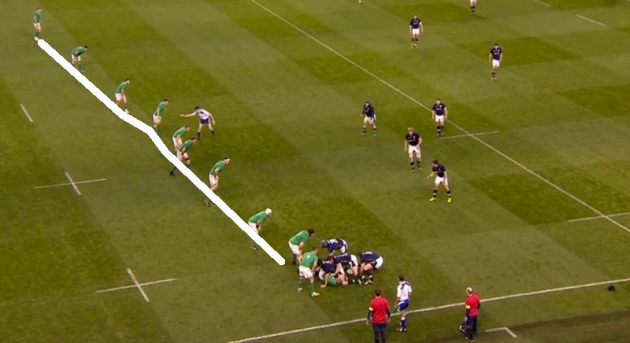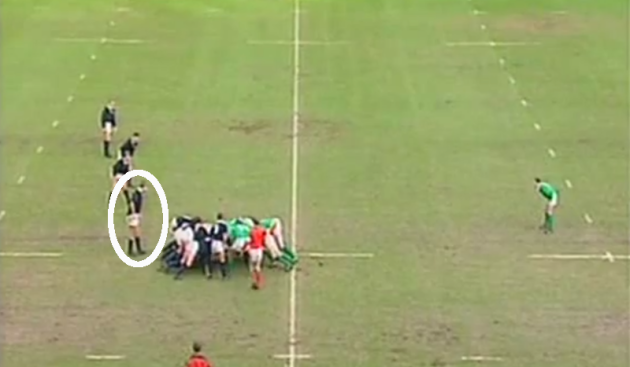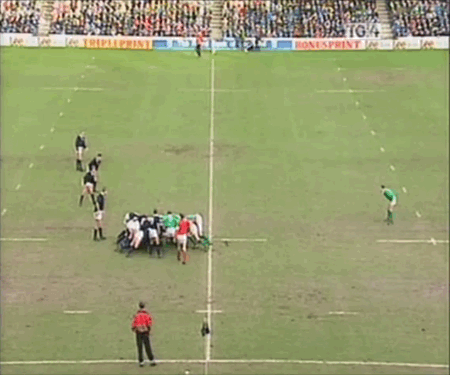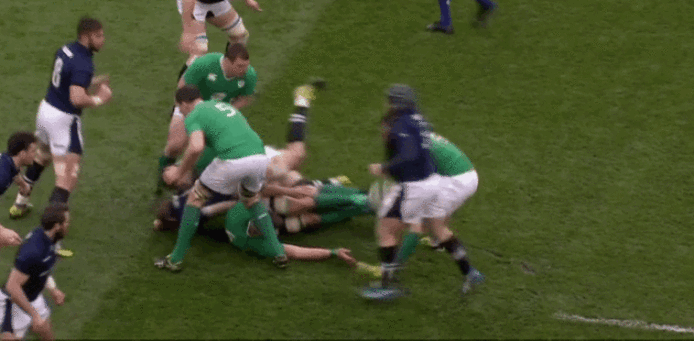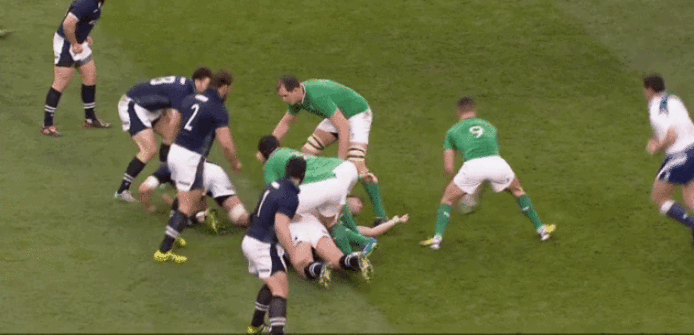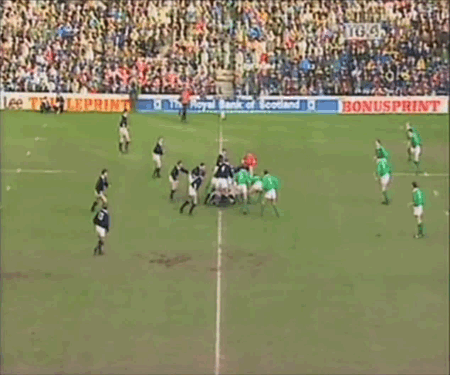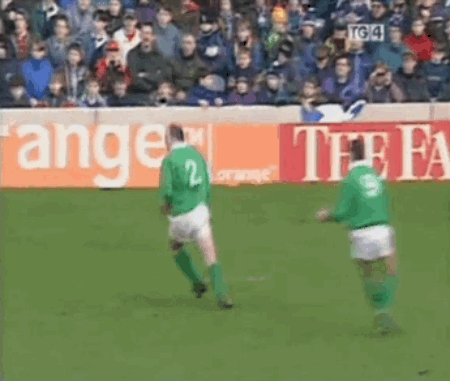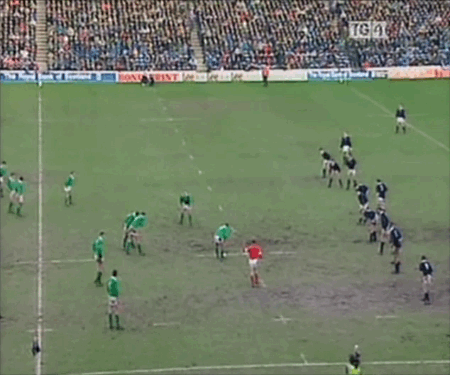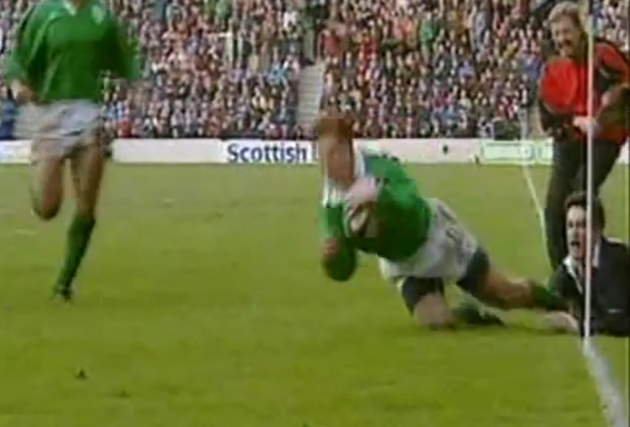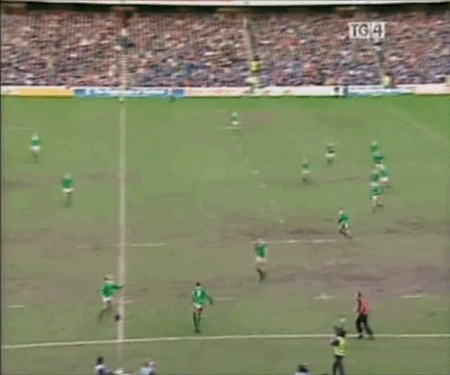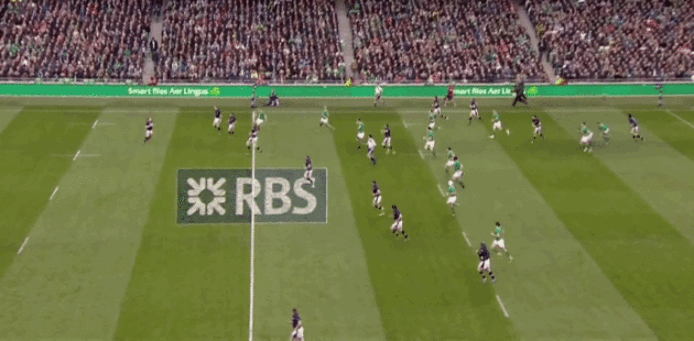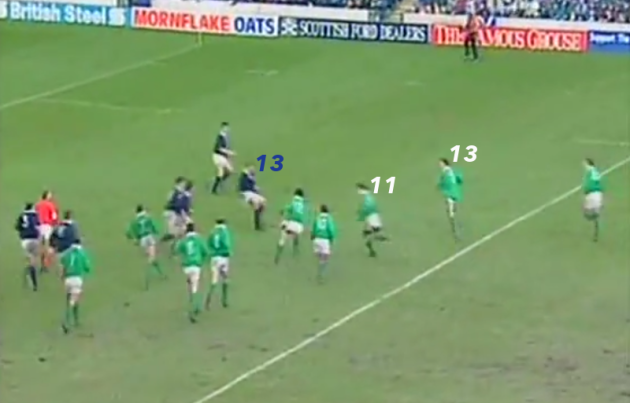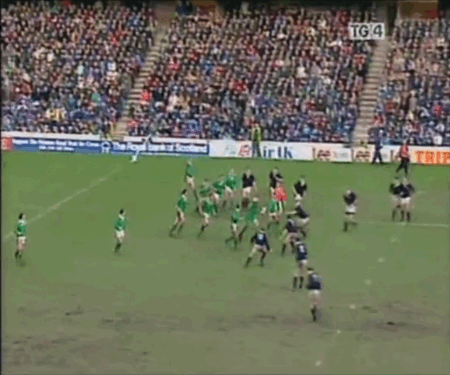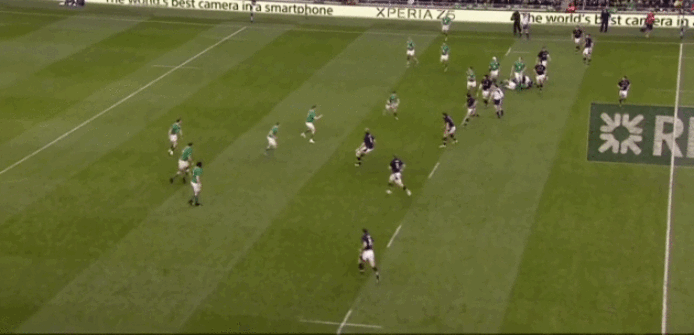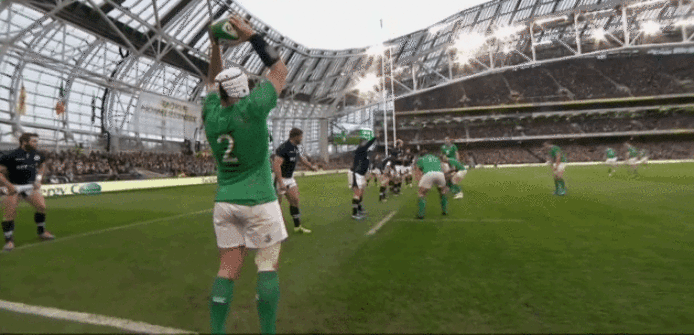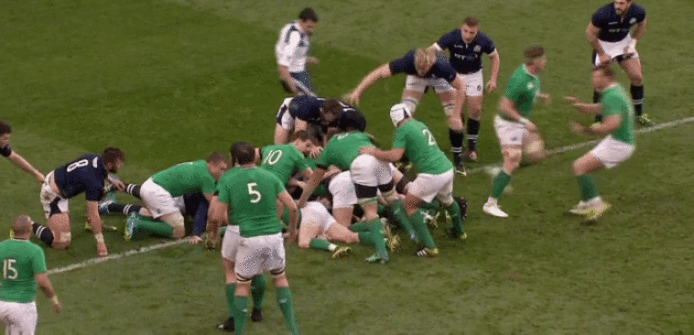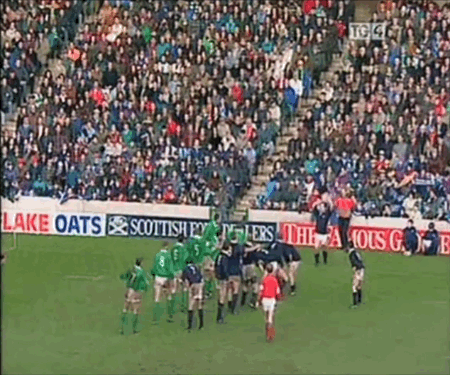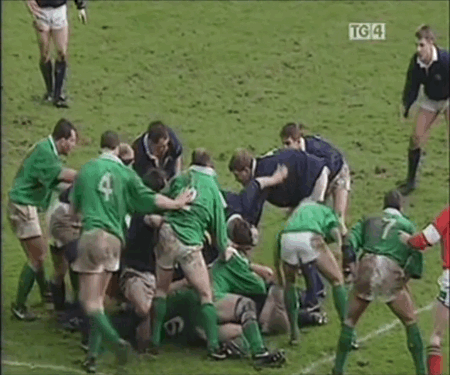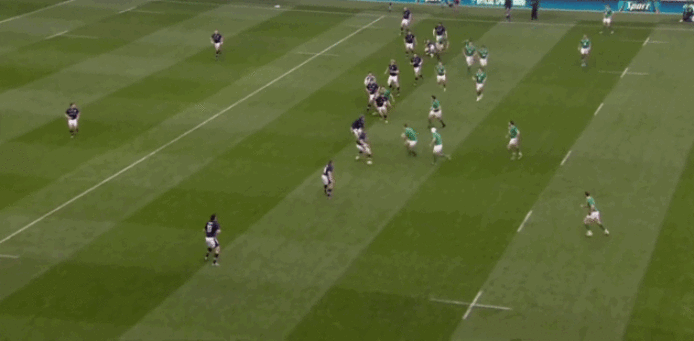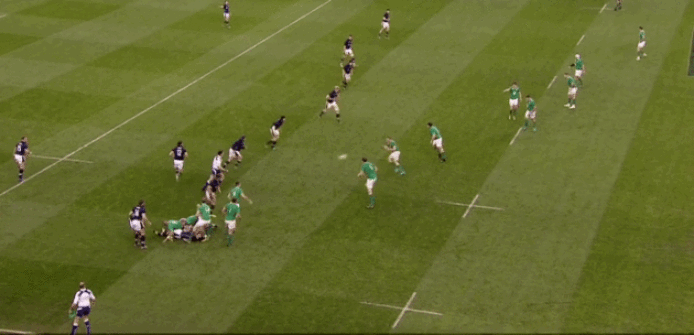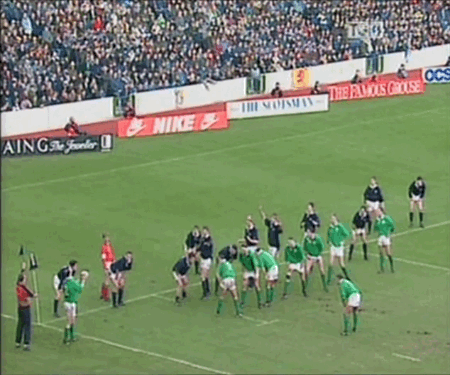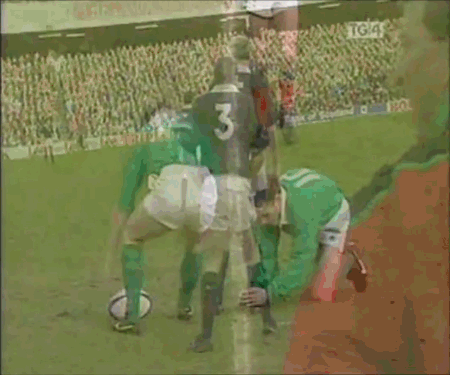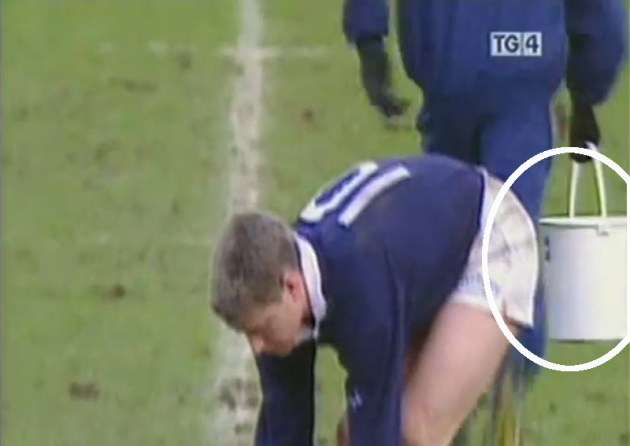PROFESSIONALISM WAS ALWAYS going to drastically change rugby, and not just in the sense that players would be paid.
With far more time to work on technical, tactical, physical and mental skills in the professional era, the sport was always certain to develop into a very different beast in terms of the fare on the pitch.
And so it has proven to be the case, with rugby in 2017 looking rather different to what we saw even in the final year of amateurism.
With Ireland set to face Scotland at Murrayfield in their Six Nations opener this Saturday, we found it fascinating to dive back to their clash in 1995 – when the Scots won 26-13 – and compare it with the meeting between the two countries last year – a 35-25 victory for Ireland.
Back in 1995, this great tournament was still the Five Nations, with Italy only joining in 2000.
1995 was also the last amateur Five Nations, with the sport of rugby union declared ‘open’ in August of that year.
Here, we note some of the key differences between the last year of amateurism and the current game, as well as some of the aspects of the game that remain similar.
Scrum
The scrum has always been and will always be a key battle ground in rugby, with teams using this set-piece to launch their attack, win penalties, or even waste time – all depending on their tactics.
But the scrum in modern-day rugby is very different to what it was in the amateur game, and it is certainly one of the least popular parts of the sport with many supporters and pundits.
On average during last year’s Six Nations, 18% of the playing time in games was taken up by scrums. In one fixture – France vs. Ireland – that figure went as high as 30%, or 23 minutes and 43 seconds in real time.
The amount of time spent on scrums wasn’t as much of a problem back in 1995.
Above, we get a fine example of why.
We can see forwards actually running hard to get to a scrum and set up quickly.
Even Ireland tighthead prop Peter Clohessy is trotting across the pitch eager to pack down.
The Young Munster man is motoring his way over from the left touchline and already the rest of both packs are on scene and ready to get stuck in.
The instant Ireland and Scotland’s packs are in position, referee Derek Bevan – who was a TMO up until last year – gives them a quick instruction and the scrum begins.
After the eye-opening speed at which the scrum is formed, we get another unfamiliar image as the front rows slam into each other on the engage.
Having become accustomed to the ‘crouch, bind, set’ system we have in the game now, it’s rather alarming to see the two front rows hammering into each other from some distance apart.
The ‘engage’ call disappeared from rugby as recently as 2013, but the scrum has been ever-changing in the professional game.
Essentially, all alterations in this department have been driven by a desire to improve player welfare and the above clip certainly does look more dangerous than what we have now.
Simply put, allowing the 120kg+ monster props of professional rugby to hammer into each other like we see above would be madness. However, the sheer amount of time spent on scrums is a huge frustration to supporters in the current era.
Below is an example from last year’s clash between Ireland and Scotland.
Everyone is simply standing around, getting their breath back, picking mud from their boots and generally waiting.
A full 10 seconds later and the packs are only beginning to bind up.
Another full 10 seconds later and, finally, we get the referee giving the players the commands to ‘crouch, bind, set’.
Note below how the props on the near side bind, therefore bringing them close together, before they ‘set’ with a much-reduced engage.
It certainly appears that the current scrum sequence is far safer, particularly with the size and power of the players taken into account, but the sheer volume of time spent on scrums during games will remain a frustration for many rugby aficionados.
The scrum in the amateur days was certainly quite messy at times and brought a dangerous risk of collapsing after the high-speed engage, but the intent to get the ball back into play quickly was a positive.
Lineout
Winning the scrum battle can be decisive in rugby, but the lineout is often just as important.
Securing anything less than 80% of one’s own throw into this set-piece can put teams in very difficult positions, denying them crucial attacking platforms and giving up important territory to the opposition.
Back in 1995 and the amateur days, the lineout still bordered on being a lottery, however.
The first thing that strikes us in the example above from the 1995 game is the throwing technique of 23-year-old Keith Wood.
As with many hookers in the amateur era, Wood favoured the one-handed throw into the lineout.
That technique slowly died out after rugby turned professional, although the likes of Raphaël Ibañez maintained the tradition for some years.
The second thing we notice in this 1995 lineout, perhaps even more strikingly, is the absence of the clear lifting of a jumper.
Pre-griping and lifting of jumpers wasn’t actually officially passed into the rugby law book until as late as 2009, but the lineout had begun to turn into the highly-organised, highly-tactical set-piece we now know it as years before then.
In 1995 that process still had a way to go, although we do get some examples of players ‘supporting’ the lineout jumper, as below.
All the way up until 2008, and a set of experimental law variations that were passed into law a year later, players were only permitted to ‘support’ their lineout jumper in this manner.
Essentially, no pre-binding or lifting was allowed but players could give their jumper a bit of a boost after they had left the ground.
There were lineout calls and teams obviously practiced in this department, but even still it was often a mess.
We can see above the habit teams had of closing the gap between the two lineouts, with elbows often flying, shoulders heading for ribs, toes being stood on and all manner of other distractions taking place.
This game gives us an example of Ireland stepping off the lineout slightly in an attempt to give themselves more room to take clean ball.
Even then, there were absolutely no guarantees.
Go to a three-man lineout? Surely some chance of success…
There were obviously lineout wins on the throw in amateur rugby and Ireland were particularly poor in this game, but the point is that the chances of success at lineout time were far slimmer back then.
Planning attacks from the lineout in those days was therefore very difficult and possibly not worth the time. Teams did prepare moves and ran them whenever possible, but the throw was nowhere near the advantage it is today.
The modern day lineout is a slick machine in comparison to what we had in the game just over 20 years ago, with teams possessing vast arrays of lineout set-ups and a number of different possible calls on each one.
Every player in the pack knows their specific role at each lineout in fine detail, with lineout leaders being able to change their call at the last second if they are forced to do so by the defensive set-up.
As such, having the throw into the lineout is a major advantage in the game now and this set-piece is an essential platform for any attack.
For teams like Ireland, it is perhaps the most important possession platform of all, given that it allows them to launch their clever ‘power plays’ involving several phases of pre-programmed attack, while also allowing them to fire up their highly-effective maul.
Defence
As with everything else in amateur rugby, the defences were far less organised than what we see in the game today.
Current-era teams have finely-detailed and tailored defensive systems so players know exactly what they should be doing in any given situation on the pitch, and also possess a wide range of techniques to halt ball carriers and slow opposition possession.
Again, the sheer amount of training time professionals have facilitates the depth of their skills and knowledge. Back in the amateur days, very little time was spent on something as essential as tackle technique.
But rugby has always been a game where physical courage has allowed players to make big plays in defence.
‘Linespeed’ is something that is so often discussed in rugby now, as teams look to rush up at pace to pressure the attack or smash them behind the gainline.
Jared Payne is the tackler in the instance above, as he makes a fine read of where the ball is going, rushes up and then makes a ball-and-all hit.
But linespeed wasn’t invented in 2016.
Jump back to our 1995 game and we can see Ireland eating up the yards to halt the Scots behind the gainline.
Fullback Conor O’Shea is the man to make the final tackle upfield, but we can see the collective Irish appetite to hammer up at Scotland.
Nonetheless, this kind of linespeed was far less common back in the amateur days, with the relative disorganisation of the defences meaning it was harder to get a cohesive line coming forward at the attack.
Oftentimes, the defence was not in an organised line to the side of the ruck in our 1995 game, with defenders arriving into position at different points and some of them simply hanging deeper even when not needed in the backfield.
Flick forward to our 2016 version of Ireland v Scotland and the defensive images are generally far more organised.
Of course, we should also note the differences in the organisation of the attack in these two instances – rugby nowadays is very structured and patterned, with some arguing that it is to the detriment of the game.
Looking back to 1995, we can see that defence at scrum time was also rather different.
On the Ireland feed, we can see that Scotland’s defensive line is not back five metres from the hindmost foot of their scrum – as teams are required to be now.
We’ve also circled Scotland’s number eight, Eric Peters, who is not even in the scrum.
Moments later, before the ball has left the scrum, Scotland openside flanker Iain Morrison also leaves the set-piece.
It’s a crazy sight for modern-day supporters, and it clearly changes the picture for the attacking teams from scrums.
2009 saw the law about defences being five metres back introduced into the law book permanently, while back rows nowadays obviously have to remain bound to the scrum until the ball has left it.
It means we get a picture like the one above at scrum time in the modern game, with Ireland’s defence a good five metres back from the hindmost foot of their scrum, and all of their back rows tied to the scrum until the ball leaves.
It clearly means more space for the attacking team and must be seen as a positive.
Kicking
Kicking is anathema to some supporters and pundits today, but all good teams spend time honing their skills and tactics in this department.
The All Blacks, the best team in the world, kick extensively, while Joe Schmidt’s Ireland also use clever kicking in many of their game plans.
In the 2016 Six Nations, Wales had the highest average kicks per game with 25, while Ireland came in third on the table with 20.
Kicking has always been a fine way of gaining territory, as Scotland out-half Craig Chalmers shows us in our 1995 game.
Rolling the ball into touch in this manner was an even more effective tool in 1995, given that the lineout was still a bit of a lottery. Find touch close to the opposition tryline and you had every chance of picking off their throw.
Even with the increased security of the lineout in the professional era, we still see teams focusing on winning the territorial battle through their kicking.
Johnny Sexton is the man to spiral the ball into touch in the 2016 example above, but this is not the only kind of kicking that the two eras have in common.
Schmidt’s Ireland are highly-efficient proponents contestable kicks – very often in the shape of the box kick, as Conor Murray sends up hanging kicks for his wings to chase and compete for.
Ireland’s goal is always to win the ball back under this type of kick.
When we dive back to 1995, we can see that similar tactics were used.
This kick comes from Ireland out-half Paul Burke, rather than scrum-half and captain Michael Bradley, but the intention is the same.
Fire a high kick over the Scottish defence, drag their fullback up from the backfield and force an error by making physical contact with him.
The 2016 version of Ireland get off the ground to compete through Andrew Trimble, while the 1995 crew get a hit in on Gavin Hastings through mobile hooker Wood. The result is the same in both cases. Plus ça change!
It would be wrong to go any further without mentioning the kick from Wood below.
The former Munster front row drops into the backfield, gathers in a Scotland kick and then spirals to touch impressively.
Rory Best, let’s see what you’ve got this weekend.
Attack
The unreliable nature of the set-piece and the higher error account meant there was less ball-in-play time in the amateur era.
Many passages of attack did not go beyond three or four phases, with knock-ons or basic errors stymying the best efforts.
Though many rugby fans remember the verve, style and skill of some of the great players of years gone by, those memories sometimes come with a degree of the rose-tinted glass.
Many games in the amateur era would be considered unwatchable now, even when defences are so excellent and often dominate games.
The level of disorganisation in defences back in the amateur era applied equally to attacking, where there was a much more ad-hoc approach. While the sheer level of detail and organisation can be a negative in modern professional rugby, the relative chaos of the amateur game also had real drawbacks.
Nonetheless, there are some similarities in the way amateur teams attacked and what we see in the current game. And there were some stunning set-piece moves leading to tries.
Free-kicks provided the attacking team with a guaranteed source of possession and the rather rare knowledge of exactly where all of their players were going to be.
In this case, Bradley launches the move for Ireland, before hitting Wood and looping off him, with Ireland’s forwards providing decoy runs inside the hooker.
From there, Burke and Brendan Mullin throw skip passes to find O’Shea hurtling into the line and beating Gregor Townsend on his outside shoulder. O’Shea’s draw and pass is brilliant, with wing Jonny Bell showing his pace to finish.
This kind of invention from free-kicks is lacking in the professional era, even if we have seen classics like ‘The Wall‘ re-emerge from time to time.
Bell’s try also allows us to see what rugby was like in the pre-Television Match Official days.
The ‘reverse-angle replays’ in 1995 appeared to show Bell’s left foot in touch after the despairing tackle of Craig Joiner.
However, there is no TMO and the try stands. Nowadays, we have interminable TMO breaks for all manner of incidents, and again it’s something that is often criticised.
Rugby has always been a sport that allows individual attacking skill to flourish.
While the Ireland team in 1995 wasn’t a particularly great one, there were some excellent players involved – Simon Geoghegan among them.
We get just a glimpse of the wing’s footwork and acceleration here after Ireland number eight Ben Cronin cleverly keeps the ball in play.
In the instance below, it’s Mullin who takes an Ireland try well after receiving a skip pass from inside centre Philip Danaher.
While modern attack often involves pre-programmed plays and moves, there is also still room for the individual skills to flourish.
We saw one fine example in the 2016 game between Ireland and Scotland, when Stuart Hogg scored a scintillating try on kick return.
Hogg’s brilliant vision, pace and sprint endurance are to the fore here, as he picks out Mike Ross in the Ireland defensive line and ruthlessly exposes the tighthead prop to score.
However, the Scotland fullback does also benefit from the off-the-ball work of wing Tommy Seymour.
We can see Seymour running a hard line off Hogg’s right shoulder, ensuring that Best [in the white scrum cap] must turn his shoulders out and worry about Seymour, leaving Ross completely exposed against Hogg’s pace.
Similarly, when we go back to Mullin’s try, we can see that the decoy run by Ireland left wing Bell [11 below] attracts Scotland outside centre Townsend [blue 13] to turn his shoulders infield, inviting Mullin [green 13] to burst past him on the outside.
This work by team-mates off the ball has always been and will always be key to attacking in rugby, despite the many changes since the sport went professional.
There was also a fondness for the offload in the amateur era, which perhaps explains why many commentators and pundits who were involved in the game before it went professional are so attached to the skill.
In the clip above, we see Ireland lock Gabriel Fulcher and blindside flanker Anthony Foley making lovely offloads, the latter off the ground after he has been tackled.
The intention was almost always to keep the ball alive after getting in behind the defence, and that remains part of the game today, even if some teams are more cautious and selective about their offloading.
Jamie Heaslip is the man to offload for Ireland above, and the circumstances are rather similar to our 1995 example – get beyond the tackle with a good carry, ensure there is support on the shoulder and then release the ball in front of the arriving player.
Of course, rugby allows teams to attack in many different ways and forward-based sorties have long been a pillar of the game.
Ireland are a team that rely heavily on their close-range attack through the pack to score many their tries, and there are several teams like them.
We see the slick lineout again in the instance above, with CJ Stander winning the ball as Jack McGrath and Donnacha Ryan lift him, before Ireland set up a maul that the Scots initially do well to slow.
However, Ireland are patient and get some momentum back into the maul, before hammering the Scotland tryline with a series of pick and jams from the forwards until Stander dives over.
This kind of attacking raid was common in the amateur era too, with many teams using their maul to make progress.
Scotland do so in the case below, as hooker Kenny Milne manages to find his man with clean ball, allowing them to set up the maul.
It’s a little less dynamic than our 2016 example, but the Scots do well to shift the maul off to the right and trundle towards Ireland’s line.
Once within striking distance, it’s lock Damian Cronin who takes on the responsibility for finishing the try.
It’s worth noting below that he takes advantage of team-mates in front of him obstructing potential tacklers.
But then those of us who watch the modern game know that all kinds of blocking, decoy-running and shepherding take place in front of the ball now, so perhaps this is simply another commonality between amateur and professional rugby.
What is definitely the same is how teams rely on their forward pack to build aggressive and effective attacks from close range.
Ruck
The ruck is one area where we might expect to see further strong similarities, but again comparing these two games side by side, the professional ruck appears to be a little cleaner.
We’re now so used to seeing images like those above, with a tackle completed before the opposition compete for a turnover only to be cleared away, with most players finishing off their feet.
It’s relatively clean and is often accompanied by a final rucking player arriving to stand ‘guard’ over the ball and protect their scrum-half.
The amateur ruck often had a similar look, particularly when teams got on the front foot in attack, but there were also messier affairs from time to time.
Players often piled into rucks in the amateur era, meaning more bodies to cause chaos but also fewer attackers on their feet if the ball was recycled – therefore, more ensuring it was more difficult to build organised team attacks.
Certainly in our Ireland versus Scotland fixture, there were many example like the one above, where the tackler rolled the tackled player onto his team’s side, blocked any possible recycle for the team in possession and saw the referee award them a scrum.
One aspect of the game that has developed hugely over the professional years is the jackal turnover.
In the instance above, it’s Scotland tighthead WP Nel who forces the turnover penalty by jackaling over the ball. It’s a skill that almost every player in the game must possess now, as teams look to steal or slow opposition possession whenever possible.
It was not part of the amateur game, with the handling of the ball at the breakdown simply not involved in the sport at that time.
One aspect of amateur rucking that has largely been removed from the game is the use of the boot to remove players who had fallen on the wrong side of the ball.
Before professionalism and into its early years, players were allowed to use their feet to encourage defenders away from the ball. The boot was supposed to be used in a backward motion – no stamping or racking knees and ankles.
The disappearance of this part of the game is heavily bemoaned by some rugby supporters and pundits.
Changes
There have obviously been many other changes in rugby from the amateur days to what we see in the game today.
Some of them have been very recent, as with the 2008 alteration that meant any ball passed back into the 22 could not be kicked out on the full for a gain of ground.
Back in 1995 that was, of course, all good.
A lineout just a metre out from the tryline, rather than the five metres that is the minimum distance today?
Yes, that was allowed back in 1995.
Modern-day packs would lick their lips at such a close-range opportunity, but the Ireland lineout failed them once again in 1995 against Scotland.
Note too that scrums were allowed within five metres of the tryline at that stage too.
While we can’t use any examples from 1995 here, we should also note that there were no substitutions during the game. It’s a rather bizarre thought in the modern game, but tactical substitutions were not introduced until 1996, when three replacements were allowed.
Before that, only injured players could be substituted, meaning the vast majority had to go the full 80 minutes.
In the game today, tactical replacements are a huge part of team strategy and the importance of possessing an impactful bench cannot be understated. Many front rows play only 50 minutes or even less in some cases.
Even down to the kick-offs at the start of each half, the game was different in 1995.
Ireland out-half Burke lines up his kick-off with the aid of sand and a helping hand from inside centre Danaher above.
There was even a sand bucket for players to build their makeshift tees…
Now, players simply use the drop kick to get each half of the game underway.
This is just one quirk of how the game used to be, but there have been many more serious and impactful changes to the sport of rugby since the dawn of professionalism in 1995.
It just makes one think – what is to come in the next 20 years?
IRELAND (1995): Conor O’Shea; Simon Geoghegan, Brendan Mullin, Philip Danaher, Jonathan Bell; Paul Burke, Michael Bradley (captain); Nick Popplewell, Keith Wood, Peter Clohessy; Paddy Johns, Gabriel Fulcher; Anthony Foley, Denis McBride, Ben Cronin.
IRELAND (2016): Simon Zebo; Andrew Trimble, Jared Payne, Robbie Henshaw, Keith Earls; Johnny Sexton, Conor Murray; Jack McGrath, Rory Best (captain), Mike Ross; Donnacha Ryan, Devin Toner; CJ Stander, Tommy O’Donnell, Jamie Heaslip.
Replacements: Richardt Strauss, Cian Healy, Nathan White, Ultan Dillane, Rhys Ruddock, Eoin Reddan, Ian Madigan, Fergus McFadden.
The42 is on Instagram! Tap the button below on your phone to follow us!
